What Makes Chinchillas Unique Compared to Other Rodents?
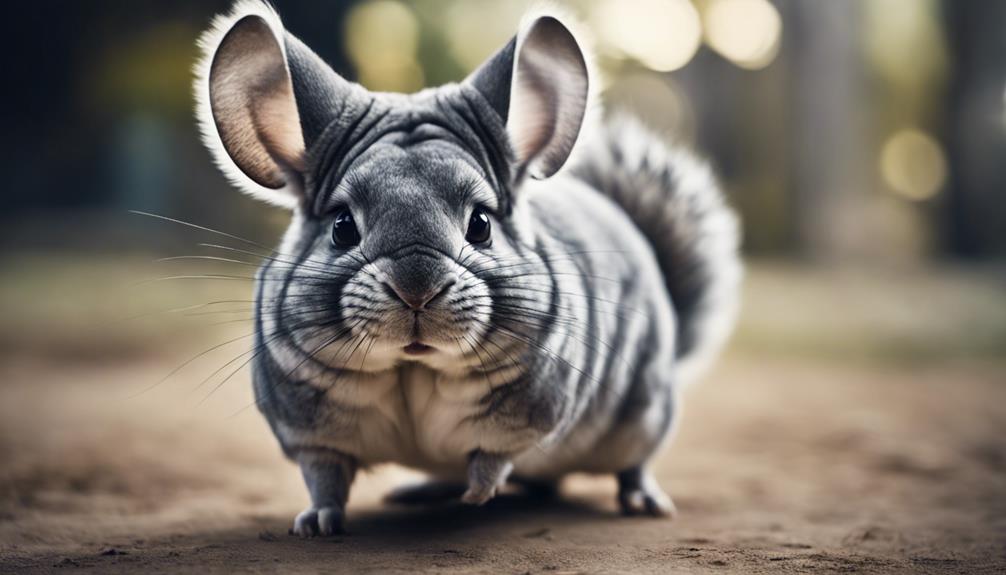
Chinchillas have incredibly dense fur, which sets them apart from other rodents. Their unique dental structure is another distinguishing feature. They engage in dust bathing behavior and are known for their nocturnal activity patterns. Additionally, chinchillas have limited water consumption.
Chinchillas stand out from other rodents due to their incredibly dense fur, unique dental structure, dust bathing behavior, nocturnal activity patterns, and limited water consumption.
Chinchilla's Dense Fur
Chinchillas possess an exceptionally dense fur that serves various essential purposes in their natural habitat. The fur density of chinchillas is remarkable, with over 60 hairs sprouting from a single follicle. This dense coat not only provides insulation against the cold temperatures of their mountainous habitats but also offers protection from predators. The fur's insulation properties help regulate the chinchilla's body temperature, preventing it from overheating or getting too cold.
In addition to its functional benefits, the fur of chinchillas is also visually striking. Chinchilla fur comes in various colors, including gray, white, beige, and black. This diverse color palette helps chinchillas blend into their rocky environments, offering them a form of camouflage against potential threats. Beyond its color, the fur is incredibly soft to the touch, making chinchillas popular in the fur trade industry.
Unique Dental Structure
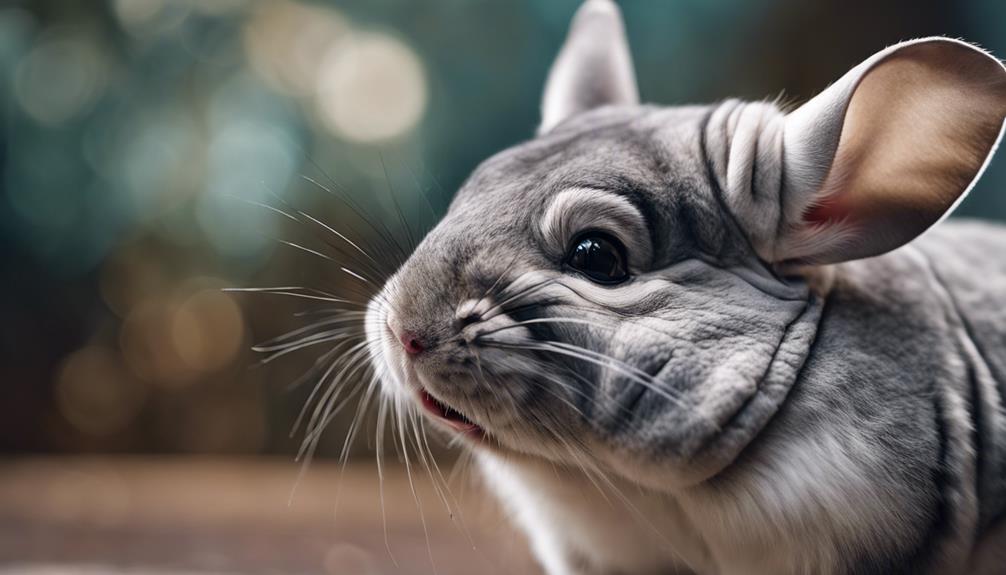
With their exceptional fur density playing a crucial role in their survival, chinchillas also possess a unique dental structure that's specialized for their dietary needs and habits. Chinchillas have open-rooted teeth, which means their incisors continue to grow throughout their lives. This continuous growth is balanced by the wear caused by their diet, which mainly consists of tough grasses and hay. The dental enamel on their incisors is incredibly strong to withstand this constant wear and tear.
Moreover, chinchillas have a distinctive molar root structure that contributes to their chewing efficiency. Their molars have deep roots that anchor them securely in place, allowing for effective grinding of their fibrous food. This adaptation enables chinchillas to break down their food efficiently before digestion, aiding in nutrient absorption.
Dust Bathing Behavior
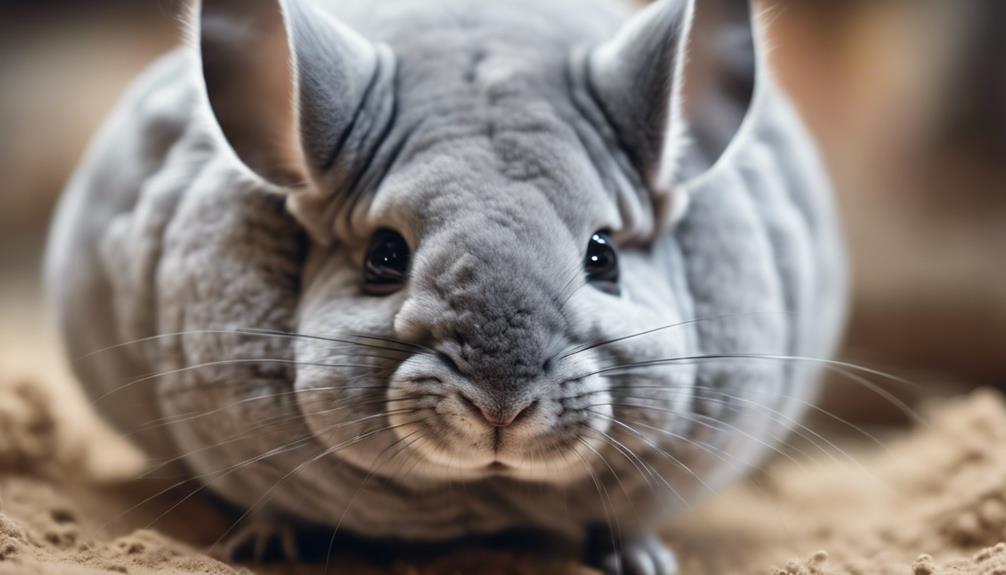
Known for their meticulous grooming habits, chinchillas engage in a unique behavior called dust bathing to maintain their fur's health and cleanliness. This behavior is essential for their hygiene maintenance and aligns with their natural instincts.
Here are some key points to consider:
- Hygiene Maintenance: Dust bathing helps chinchillas remove excess oils and dirt from their fur, preventing matting and skin issues.
- Natural Instincts: Chinchillas in the wild use dust baths to mimic their natural habitat, where they roll in volcanic ash to stay clean and healthy.
- Environmental Enrichment: Providing chinchillas with dust baths not only fulfills their grooming needs but also serves as a form of environmental enrichment, keeping them mentally stimulated.
- Behavioral Health: Engaging in dust bathing allows chinchillas to exhibit natural behaviors, reducing stress and promoting overall behavioral health.
Understanding and supporting chinchillas in their dust bathing behavior is crucial for their well-being and overall happiness.
Nocturnal Activity Patterns

Chinchillas boast unique sleep habits that revolve around their nocturnal nature, making them most active during the night.
Their behavior at night showcases a range of activities, from exploring their surroundings to engaging in social interactions.
These nocturnal adaptations help chinchillas thrive in their natural habitats, demonstrating their remarkable ability to navigate the darkness.
Unique Sleep Habits
During the night, chinchillas display unique sleep habits, often engaging in active nocturnal activity patterns. Their sleep cycles are adapted to fit their natural environment, where they're most active at dusk and dawn. Here are some fascinating aspects of chinchillas' sleeping behavior:
- Light sleepers: Chinchillas are light sleepers, always staying alert to potential dangers even while resting.
- Quick awakenings: They can awaken rapidly from sleep, ready to react to any disturbances.
- Short naps: Chinchillas take short naps throughout the night, enabling them to rest while staying vigilant.
- Social sleepers: These rodents often sleep in groups, finding safety and comfort in numbers.
Understanding these unique sleep habits sheds light on the intriguing world of chinchilla behavior.
Active Night Behavior
Active during the night, chinchillas exhibit distinctive nocturnal activity patterns that showcase their natural adaptability and agility. Known for their playful antics and sudden energy bursts, these small rodents engage in a variety of behaviors under the cover of darkness.
Chinchillas are most active during the twilight hours, displaying a burst of energy that includes running, jumping, and exploring their surroundings. Their agile movements and quick reflexes allow them to navigate their environment with ease, showcasing their prowess in the nighttime domain.
This nocturnal behavior is a crucial aspect of their natural instincts, enabling them to avoid predators and find food in the wild. Chinchillas' active night behavior highlights their unique characteristics among rodents, making them fascinating creatures to observe.
Nocturnal Adaptations
With their keen senses and agile bodies, chinchillas effortlessly navigate their nighttime environment, showcasing remarkable adaptations for nocturnal activity patterns.
These adaptations include:
- Enhanced Vision: Chinchillas have large eyes that are specially adapted for low-light conditions, allowing them to see clearly in the dark.
- Sensitive Whiskers: Their whiskers are highly sensitive, helping them navigate through the darkness and detect obstacles in their path.
- Silent Movement: Chinchillas move stealthily during nocturnal hunting, thanks to their padded feet that make almost no sound as they traverse their surroundings.
- Efficient Metabolism: Their bodies are optimized for nighttime activity, with energy reserves that support their nocturnal behavior and hunting instincts.
Limited Water Consumption
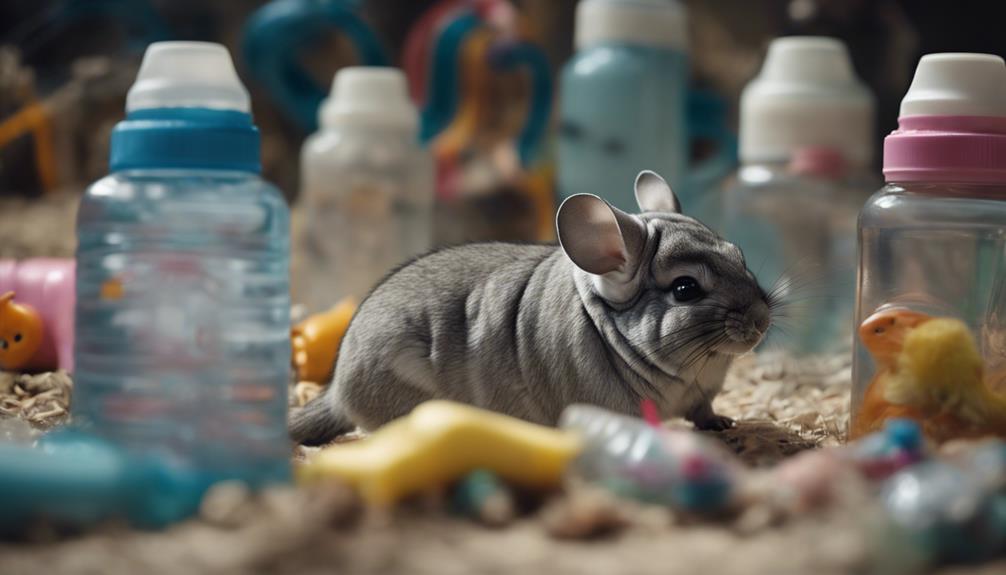
Chinchillas exhibit a unique behavior of limited water consumption compared to other rodents. This trait is a result of their desert adaptation and survival strategies. In their natural habitat of the Andes Mountains in South America, chinchillas have evolved to conserve water due to the scarcity of easily accessible water sources. This water conservation behavior helps them meet their hydration needs efficiently in the arid environment they inhabit.
Unlike many other rodents that rely on regular water intake, chinchillas have adapted to obtain moisture from their food and minimize the amount of water they drink. Their diet of hay, grasses, and herbs contains sufficient moisture to sustain them, reducing their dependence on external water sources. By minimizing water loss through their urine and feces, chinchillas have developed an effective strategy to thrive in their challenging environment.
This unique ability to limit water consumption showcases the remarkable adaptations that chinchillas have developed to ensure their survival in the harsh conditions of the desert-like Andean region.
Jumping Abilities
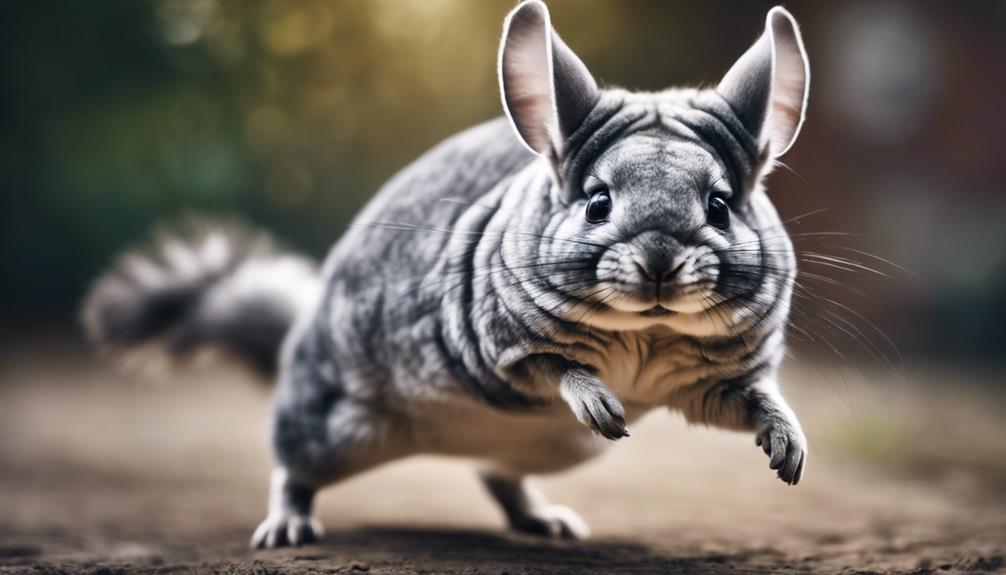
Known for their impressive agility and acrobatic prowess, chinchillas demonstrate remarkable jumping abilities that set them apart from other rodents. These small creatures are capable of astonishing feats, showcasing their agility in various ways:
- High jumps: Chinchillas are known for their ability to jump to great heights, often reaching up to 6 feet in a single bound. This skill allows them to navigate their rocky mountainous habitats with ease.
- Agility in action: Their agility is evident in the swift and precise movements they make while navigating complex terrains. Chinchillas can swiftly change direction mid-air, showcasing their exceptional coordination.
- Bounding with grace: When chinchillas engage in bounding, they exhibit a graceful and fluid motion that's mesmerizing to watch. This skill aids them in evading predators and exploring their surroundings with confidence.
- Leaping prowess: Chinchillas are proficient leapers, effortlessly jumping from perch to perch in search of food or to find a secure spot for rest. Their muscular hind legs provide them with the power needed for these impressive leaps.
Witnessing a chinchilla's acrobatic displays is a true testament to their unique jumping abilities and remarkable agility.
Social Behavior
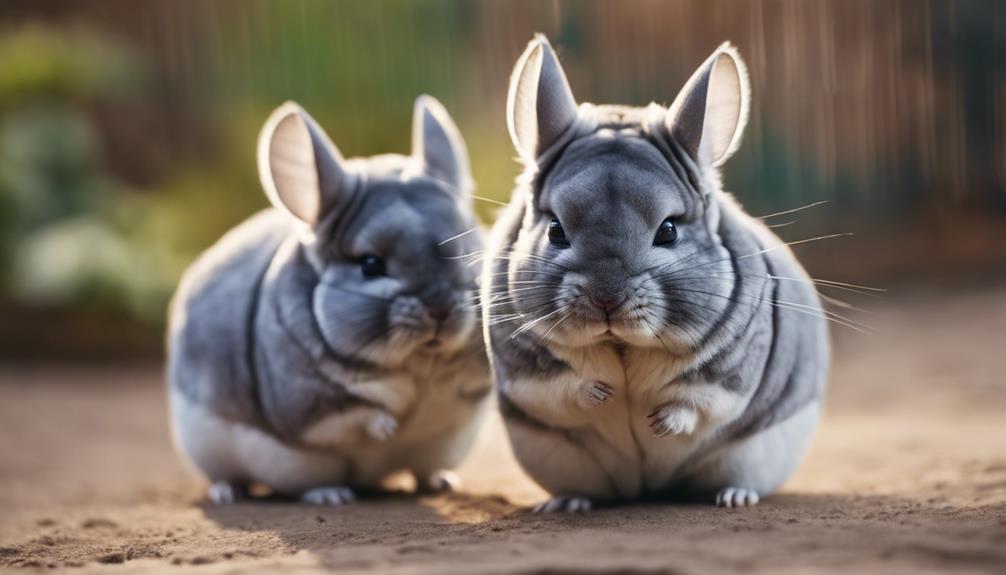
Impressively agile in their movements, chinchillas also exhibit intriguing social behaviors that highlight their complex interactions within their colonies. Chinchillas are highly social animals that thrive in group settings, displaying fascinating group dynamics and communication signals to maintain harmony within their communities. These fluffy rodents use various vocalizations, such as chirps and barks, along with body language cues like grooming and scent marking to convey messages and establish hierarchy within the group.
| Social Behavior | Description |
|---|---|
| Group dynamics | Chinchillas live in colonies and rely on social interactions for security and companionship. They often groom each other to strengthen social bonds and reduce tension. |
| Communication signals | Chinchillas use vocalizations and body language to convey messages within their groups. They have specific sounds for expressing danger, mating interest, and playfulness. |
| Mating rituals | Chinchillas have elaborate mating rituals involving courtship displays and vocalizations. Males may compete for females, showcasing territorial boundaries and dominance within the group. |
| Territorial boundaries | Chinchillas mark their territories with scent glands located on their bodies. They use these boundaries to define personal space and establish areas for feeding and nesting. |
Frequently Asked Questions
How Long Do Chinchillas Typically Live in Captivity?
Chinchillas typically live around 10-15 years in captivity, showcasing their resilience and adaptability. Their habitat influences their lifespan, with breeding and behavior playing crucial roles in their longevity and overall well-being.
What Kind of Predators Do Chinchillas Face in the Wild?
Chinchillas in the wild face natural predators like foxes, birds of prey, and snakes. They rely on their keen sense of hearing and agility to evade danger. Their adaptations include blending into their rocky habitat and being crepuscular.
Are There Any Special Considerations for Feeding Chinchillas?
When caring for chinchillas, it's crucial to consider their dental care, dietary needs, treat options, and exercise requirements. Providing proper nutrition, dental chews, hay, limited treats, and a spacious environment ensures their well-being.
Can Chinchillas Be Trained to Do Tricks or Respond to Commands?
Chinchillas can be trained to do simple tricks and respond to commands, but their training potential has limitations. Providing behavioral enrichment opportunities like obstacle courses or clicker training can help stimulate their active minds and build a stronger bond with their owners.
Are There Any Specific Health Issues or Diseases That Chinchillas Are Prone To?
Chinchillas are prone to several health issues. They may face respiratory and dental problems, as well as issues with parasites affecting their gastrointestinal system. Regular veterinary check-ups and a balanced diet are crucial for their well-being.










